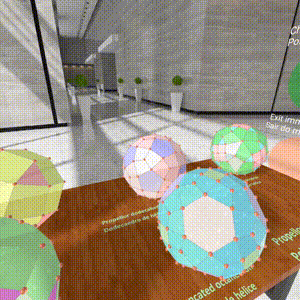Visualization of polyhedra with Augmented Reality (AR) and Virtual Reality (VR) in A-frame
author: Paulo Henrique Siqueira - Universidade Federal do Paraná
contact: paulohscwb@gmail.com
versão em português
 Propellor polyhedra
Propellor polyhedra
The polyhedra of this page were created by applying George Hart’s propellor operation to the Platonic solids and some of the Archimedean and Catalan solids. Each face is surrounded by a “propellor” of quadrilaterals, with rotational symmetry of its underlying Platonic solid.
Augmented Reality | 3D Models | Home
Immersive room
Augmented Reality
To view propellor polyhedra in AR, simply visit:
https://paulohscwb.github.io/polyhedra2/propellor/ra.html
with any browser with a webcam device (smartphone, tablet or notebook).
Access to the VR sites is done by clicking on the blue circle that appears on top of the marker.


3D models
1. Propellor tetrahedron


A propellor tetrahedron is a polyhedron obtained by performing propellor operations on a regular tetrahedron.
Faces: 4 equilateral triangles and 12 kites | Edges: 30 | Vertices: 16. More…
2. Propellor cube


A propellor cube is a polyhedron obtained by performing propellor operations on a cube.
Faces: 6 squares and 24 kites | Edges: 60 | Vertices: 32. More…
3. Propellor octahedron


A propellor octahedron is a polyhedron obtained by performing propellor operations on a regular octahedron.
Faces: 8 equilateral triangles and 24 kites | Edges: 60 | Vertices: 30. More…
4. Propellor icosahedron


A propellor icosahedron is a polyhedron obtained by performing propellor operations on a regular icosahedron.
Faces: 20 equilateral triangles and 60 kites | Edges: 150 | Vertices: 72. More…
5. Propellor dodecahedron


A propellor dodecahedron is a polyhedron obtained by performing propellor operations on a regular dodecahedron.
Faces: 12 regular pentagons and 60 kites | Edges: 150 | Vertices: 80. More…
6. Propellor truncated octahedron


A propellor truncated octahedron is a polyhedron obtained by performing propellor operations on an Archimedean truncated octahedron.
Faces: 6 squares, 8 hexagons and 72 quadrilaterals | Edges: 180 | Vertices: 96. More…
7. Propellor tetrakis hexahedron


A propellor tetrakis hexahedron is a polyhedron obtained by performing propellor operations on a Catalan tetrakis hexahedron.
Faces: 24 acute triangles, 24 kites and 48 quadrilaterals | Edges: 180 | Vertices: 86. More…
8. Propellor snub cube


A propellor snub cube is a polyhedron obtained by performing propellor operations on an Archimedean snub cube.
Faces: 8 equilateral triangles, 24 acute triangles, 6 squares and 120 quadrilaterals | Edges: 300 | Vertices: 144. More…
9. Propellor pentagonal icositetrahedron


A propellor pentagonal icositetrahedron is a polyhedron obtained by performing propellor operations on a Catalan pentagonal icositetrahedron.
Faces: 48 kites, 72 quadrilaterals and 24 pentagons | Edges: 300 | Vertices: 158. More…
10. Propellor truncated cuboctahedron


A propellor truncated cuboctahedron is a polyhedron obtained by performing propellor operations on an Archimedean truncated cuboctahedron.
Faces: 12 rhombi, 150 quadrilaterals, 6 octagons and 8 hexagons | Edges: 360 | Vertices: 192. More…
11. Propellor disdyakis dodecahedron


A propellor disdyakis dodecahedron is a polyhedron obtained by performing propellor operations on a Catalan disdyakis dodecahedron.
Faces: 48 acute triangles and 144 quadrilaterals | Edges: 360 | Vertices: 170. More…
12. Propellor truncated icosahedron


A propellor truncated icosahedron is a polyhedron obtained by performing propellor operations on an Archimedean truncated icosahedron.
Faces: 12 regular pentagons, 20 hexagons and 180 quadrilaterals | Edges: 450 | Vertices: 240. More…
13. Propellor pentakis dodecahedron


A propellor pentakis dodecahedron is a polyhedron obtained by performing propellor operations on a Catalan pentakis dodecahedron.
Faces: 60 acute triangles, 60 kites and 120 quadrilaterals | Edges: 450 | Vertices: 212. More…
14. Propellor truncated icosidodecahedron


A propellor truncated icosidodecahedron is a polyhedron obtained by performing propellor operations on an Archimedean truncated icosidodecahedron.
Faces: 30 rhombi, 20 hexagons, 12 decagons and 360 quadrilaterals | Edges: 900 | Vertices: 480. More…
15. Propellor disdyakis triacontahedron


A propellor disdyakis triacontahedron is a polyhedron obtained by performing propellor operations on a Catalan disdyakis triacontahedron.
Faces: 120 acute triangles and 360 quadrilaterals | Edges: 900 | Vertices: 422. More…

Propellor polyhedra - Visualization of polyhedra with Augmented Reality and Virtual Reality by Paulo Henrique Siqueira is licensed with a license Creative Commons Attribution-NonCommercial-NoDerivatives 4.0 International.
How to cite this work:
Siqueira, P.H., "Propellor polyhedra - Visualization of polyhedra with Augmented Reality and Virtual Reality". Available in: <https://paulohscwb.github.io/polyhedra2/propellor/>, November 2023.
References:
Weisstein, Eric W. “Archimedean Solid” From MathWorld-A Wolfram Web Resource. http://mathworld.wolfram.com/ArchimedeanSolid.html
Weisstein, Eric W. “Platonic Solid” From MathWorld-A Wolfram Web Resource. http://mathworld.wolfram.com/PlatonicSolid.html
Weisstein, Eric W. “Catalan Solid” From MathWorld-A Wolfram Web Resource. https://mathworld.wolfram.com/CatalanSolid.html
Wikipedia https://en.wikipedia.org/wiki/Archimedean_solid
Wikipedia https://en.wikipedia.org/wiki/Platonic_solid
McCooey, David I. “Visual Polyhedra”. http://dmccooey.com/polyhedra/
